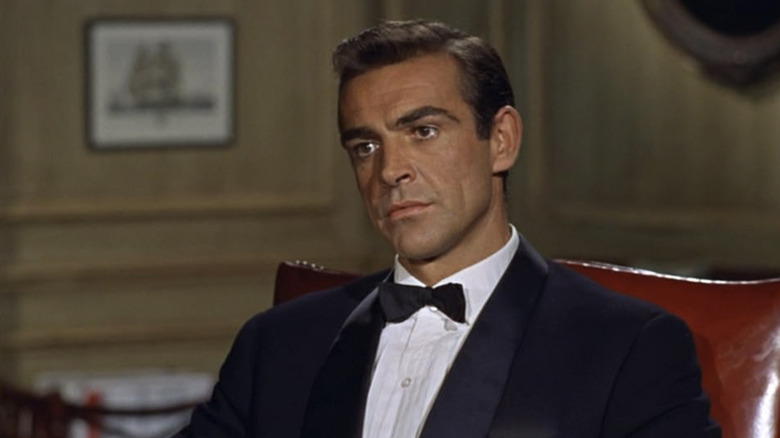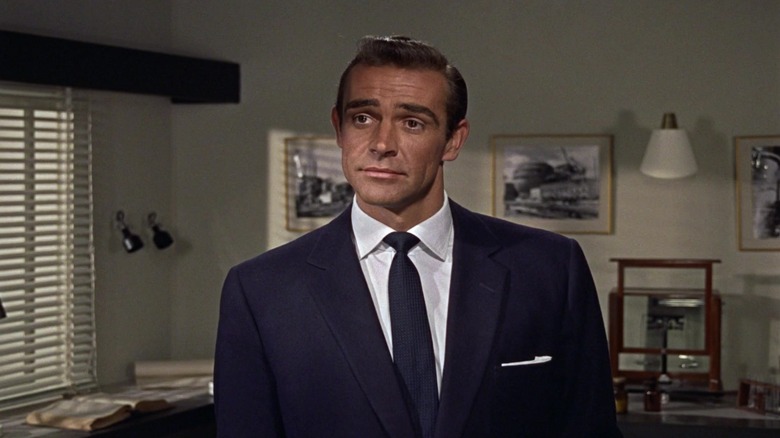Sean Connery Made Far Less Than You'd Expect For The First James Bond Movie
Terence Young's "Dr. No," as anyone can tell you, was the first theatrically released feature film to headline Ian Fleming's notoriously capable MI6 agent James Bond. It was released in 1962, and it kicked off a long series of high-profile, big-budget action pictures that persist to this day. Sean Connery played James Bond in "Dr. No," and he reprised the role in five additional sequels (or six, if you want to get into hairsplitting conversations about the nature of James Bond canon). Over the years, of course, various other actors have stepped in to play the role, each one with their strengths, weaknesses, and devoted fanboys. I, personally, am fond of Pierce Brosnan, and I will not apologize for that.
Curiously, "Dr. No" was adapted from Ian Fleming's sixth James Bond novel, and not the first, "Casino Royale." The story goes that the James Bond producing team of Albert R. Broccoli and Harry Saltzman wanted to adapt Fleming's eighth 007 novel "Thunderball," but there were some sticky rights issues with that novel's co-author. "Dr. No" was selected instead, and production began. Finding Sean Connery for the part was nothing extraordinary. He was one of several actors being considered (Cary Grant and David Niven were also being looked at), and Connery just happened to nail his audition. He signed on for five pictures, and the rest his history.
What isn't as well-known is Connery's salary for "Dr. No," although Connery made no secret of saying how low he thought it was. Back in 1965, Connery was interviewed by Playboy Magazine (an interview handily archived by the 007 Dossier website), and he revealed that for the one film, he only received 6,000 pounds. Even adjusted for exchange rates and inflation, that's still very little.
Sean Connery was only paid £6,000 for Dr. No
Playboy just asked Connery outright how much he got paid, and he said it was a mere £6,000. After some calculating of the historical conversion rates, and subsequent updating to reflect inflation, still only equals about $214,868 in 2025 U.S. dollars. Compare that to the $25 million Daniel Craig received to appear in 2021's "No Time to Die."
The Playboy interviewer pointed out that, even as early as 1965, Connery had already received a hefty raise, earning about $500,000 per picture. Connery didn't want to gossip about his earnings, though, saying that he spends judiciously. "I have respect for its value," he said, adding that "I come from a background where there was little money and we had to be content with what there was." Indeed, Connery's parents were wageworkers, with a mother who worked as a cleaning lady, and a father who worked in a factory.
Connery continued by saying that he is always sharply aware of his bottom line. He admitted that he bought a Jaguar (second-hand), and that he bought his own home and the acre of land it rests on, but that he doesn't want to fall into the trap of living extravagantly without thought. The actor said:
"I don't invest in land, and I don't have a lot of servants; just a secretary and a nanny for the children. Old habits die hard. Even today, when I have a big meal in a restaurant. I'm still conscious that the money I'm spending is equal to my dad's wages for a week. I just can't get over that. Even though I sign the bill and don't actually pay in cash. But I still prefer the feel of real money to a checkbook. And I'm still the sort of fellow who hates to see a light left on in a room when no one is there."
For his final on-screen performance, "The League of Extraordinary Gentlemen," Connery was reportedly paid $17 million. Let's hope he was frugal with it.

